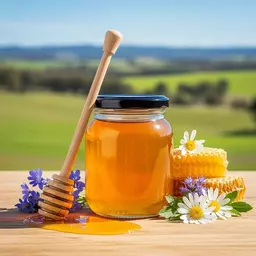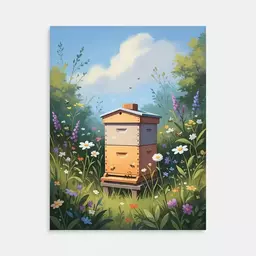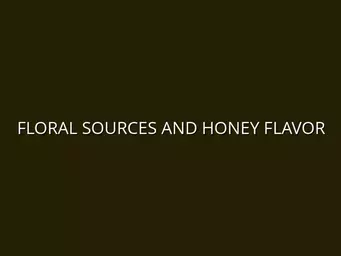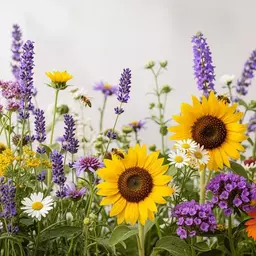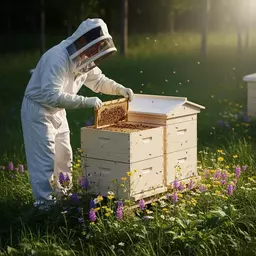Seasonal Flower Guide for Bees
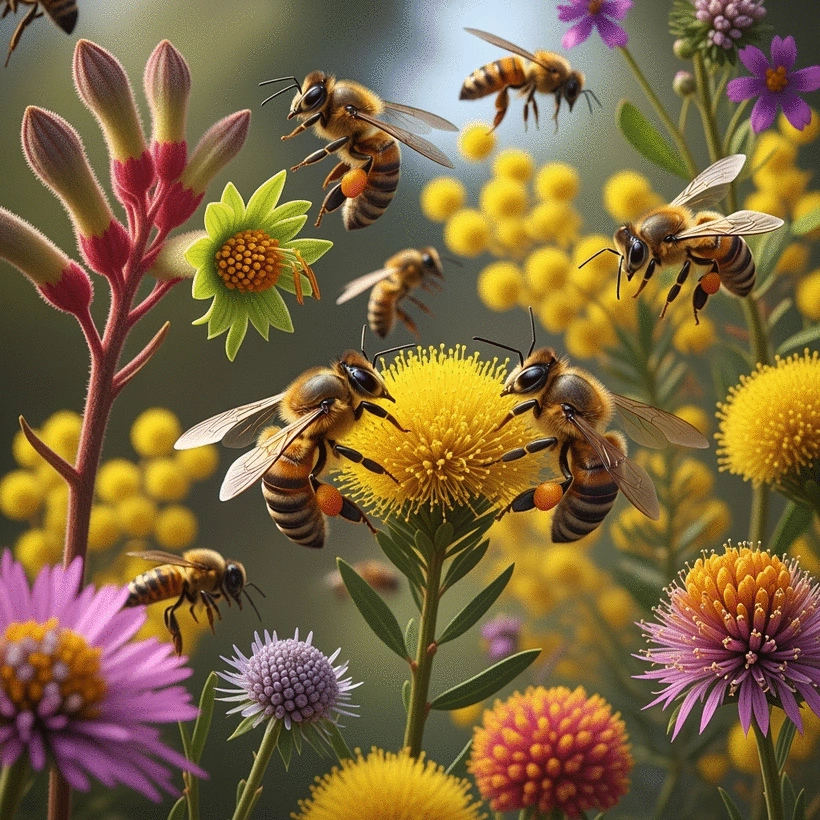
Consider this: approximately one-third of the food we eat relies on the tireless work of honey bees. Their health is directly tied to the flowers they forage from. By understanding their needs, we can help sustain both their colonies and our food supply. Let's explore the essential insights from this article!
What You Will Learn
- Honey bees require specific flowers rich in nectar and pollen to maintain their energy and health.
- Diverse pollen sources are crucial for the nutrition of bees, promoting healthier colonies.
- The process of honey production is reliant on nectar collection and the transformation within the hive.
- Seasonal forage planning is essential for providing continuous blooms that support bee populations year-round.
- Incorporating native and flowering plants like lavender, sunflowers, and clover in gardens can create a thriving environment for honey bees.
Nectar & Pollen: The Lifeblood of Honey Bees
This visual highlights the critical roles of nectar and pollen in honey bee survival and honey production, alongside essential floral sources and seasonal foraging strategies.
Nectar & Pollen Roles
Nectar: Energy source, converts to honey.
Pollen: Protein for larvae & colony health.
Key Foraging Needs
- ● Energy Requirements
- ● Nutrient Diversity
- ● Pollination Efficiency
Seasonal Forage
Spring: Eucalypts
Summer: Lavender
Autumn: Native Bush Peas
Essential Plant Sources
- ✓ Lavender
- ✓ Sunflowers
- ✓ Wildflowers
Understanding the Importance of Nectar and Pollen for Honey Bees
As a passionate apiarist and environmental advocate, I’ve seen firsthand how vital nectar and pollen are for our beloved honey bees. These tiny creatures depend on specific flowers for foraging, and their survival hinges on our understanding of these essential resources. Without the right floral sources, honey bees struggle to thrive, impacting not only their colonies but also the wider ecosystem.
When bees visit flowers, they collect nectar, a sugary liquid that they turn into honey, and pollen, which serves as their primary source of protein. This dynamic duo is crucial for maintaining healthy bee colonies. Research has shown that the availability of diverse pollen sources significantly impacts bee health and colony survival, as detailed in studies like this one on honey bee nutritional ecology. So, let’s dive into why these floral resources matter so much!
Why Honey Bees Need Specific Flowers for Foraging
Honey bees are highly selective foragers. They often prefer flowers with particular characteristics, such as scent, shape, and color. Nectar-rich flowers are especially important as they provide the energy needed for bees to perform their vital pollination roles. But why do the specifics really matter?
- Energy Requirements: Different flowers produce varying amounts of nectar, which directly affects the energy bees gain from foraging.
- Nutrient Diversity: Pollen from diverse floral sources enriches the diet of bees, promoting healthier colonies. The importance of diverse pollen for honey bee health is further emphasized by research on pollen consumption and pathogen resistance.
- Pollination Efficiency: Certain flowers attract bees more effectively, ensuring they get the pollination done efficiently, which benefits both the bees and the plants.
By understanding these preferences, we can plant the right varieties in our gardens, creating a haven for honey bees to thrive!
The Role of Nectar and Pollen in Honey Production
Nectar and pollen are not just food for honey bees; they are the building blocks of honey production. When bees forage for nectar, they bring it back to the hive, where it undergoes a fascinating transformation. This process involves enzymes and evaporation, ultimately resulting in the honey we all love!
- Nectar Collection: Bees collect nectar and store it in their "honey stomachs" for transportation.
- Pollen Gathering: Pollen is mixed with nectar to create "bee bread," which serves as nourishment for developing larvae.
- Honey Formation: Through evaporation and enzyme activity, the nectar is converted into honey, a crucial food source for the colony. Understanding these processes is key to appreciating the ecosystem services provided by bees, including their role in sustaining global agriculture.
Understanding this process highlights the importance of sustaining floral sources to ensure our honey bees can produce the best honey possible. So, what's your favorite type of honey? It's amazing how much the source can influence flavor!
Essential Nectar and Pollen Sources for Healthy Bee Colonies
To keep our honey bees buzzing and healthy, we need to provide a variety of nectar and pollen sources throughout the seasons. Here are some essential flowers that can attract bees and support their health:
- Lavender: Known for its aromatic scent and rich nectar.
- Sunflowers: Tall and bright, they’re a favorite for bees seeking pollen.
- Wildflowers: Native wildflowers provide diverse foraging opportunities.
- Clover: A staple for both nectar and pollen, clover is a must-have in any bee garden.
By incorporating these flowers into our gardens, we can create a thriving environment for honey bees, ensuring they have a steady food supply. Let’s work together to cultivate these essential resources and keep our pollinators strong!
Pro Tip
Did you know? Planting a variety of native flowers not only attracts honey bees but also supports the entire pollinator population. By choosing plants that bloom at different times throughout the year, you can create a continuous food supply, ensuring your bees stay healthy and productive!
Recap of Seasonal Forage Planning for Honey Bees
As we wrap up our discussion on seasonal forage planning, it’s clear that understanding the timing and selection of flowers is crucial for the health of our honey bees. By carefully choosing plants that bloom throughout the seasons, we can provide a steady food source that keeps our colonies thriving. Remember, every flower counts in creating a supportive environment for our buzzing friends!
To ensure your beekeeping efforts yield the best results, keep these key takeaways in mind:
- Plan for continuous blooms to cover all seasons.
- Choose native plants that are well-adapted to local conditions.
- Consider the nutritional needs of bees when selecting flowers.
- Create a diverse floral environment to support various bee species.
By implementing these strategies, you’ll be well on your way to fostering a flourishing bee garden that not only benefits your hives but also enhances the overall ecosystem in your area.
Key Takeaways on Flower Selection for Australian Beekeepers
When selecting flowers for your bee-friendly garden, it’s important to think about both the type of plants and their blooming times. Here are some essential insights:
- Spring: Focus on early bloomers like Eucalypts and Wattle to help bees regain strength after winter.
- Summer: Include plants like Lavender and Sunflowers that provide abundant nectar during peak bee activity.
- Autumn: Choose Native Bush Peas and Hibiscus to prepare bees for the colder months ahead.
With these selections, we can ensure our bees have the resources they need at every stage of the year. At Nectar Network, we encourage beekeepers to observe their local ecosystems and adapt their flower choices accordingly.
Final Thoughts on Supporting Honey Bees Through Gardening
Supporting honey bees goes beyond just planting a few flowers; it’s about creating a sanctuary where they can thrive. As an avid apiarist, I’ve learned that the health of our bees is intricately tied to the diversity of their foraging options. By providing a variety of flowering plants, we’re not only helping our honey bees but also contributing to the rich tapestry of our local environment.
So, whether you’re a seasoned beekeeper or just starting out, remember to think like a bee! What do they need? A vibrant garden filled with delicious nectar and pollen sources that support their health and our ecosystem. Together, we can all play a part in nurturing our precious pollinators!
Frequently Asked Questions About Honey Bees and Foraging
- Why are specific flowers essential for honey bees?
Honey bees require specific flowers because these plants offer optimal amounts of nectar for energy and diverse pollen for protein, which are crucial for their health, colony growth, and honey production. Different flowers also attract bees more effectively, enhancing pollination efficiency. - What role do nectar and pollen play in honey production?
Nectar is collected by bees as a sugary liquid and transformed into honey within the hive through enzymatic reactions and evaporation, serving as the colony's primary energy source. Pollen is mixed with nectar to create "bee bread," which provides essential proteins and nutrients for developing larvae and the overall health of the colony. - Which plants are best for attracting honey bees?
Essential plants for attracting honey bees include lavender, sunflowers, wildflowers, and clover. These plants provide rich sources of nectar and pollen and are favored by bees. Planting a diverse range of native flowers that bloom at different times of the year ensures a continuous food supply. - How does seasonal forage planning benefit honey bees?
Seasonal forage planning ensures that honey bees have a consistent and diverse food supply throughout the year. By planting flowers that bloom in spring (e.g., Eucalypts, Wattle), summer (e.g., Lavender, Sunflowers), and autumn (e.g., Native Bush Peas, Hibiscus), beekeepers can support bee health and productivity across all seasons, helping colonies thrive. - What steps can urban beekeepers take to support local flora conservation?
Urban beekeepers can support local flora conservation by choosing appropriate hive locations, regularly maintaining gardens with diverse flowering plants (especially native species), and engaging with neighbors and local businesses to promote bee-friendly practices. These actions help integrate urban beekeeping with local ecosystem health.
Engaging with the Beekeeping Community
Resources for Further Learning about Bee-Friendly Plants
To deepen your understanding of how to create a bee-friendly environment, there are numerous resources available:
- Local gardening clubs focused on sustainable practices.
- Online forums where beekeepers share tips and experiences.
- Books and guides on native flora and pollinator gardens.
- Workshops hosted by local environmental organizations.
These resources can provide invaluable insights and help you connect with like-minded individuals who share your passion for honey bees.
Encouraging Local Initiatives to Support Pollinator Health
Community initiatives play a crucial role in enhancing the health of our local ecosystems. Consider joining or starting a program aimed at:
- Restoring native habitats.
- Educating others about the importance of pollinators.
- Promoting the use of bee-friendly practices in landscaping.
Through collective efforts, we can create environments that not only support our honey bees but also enrich our communities.
Best Practices for Urban Beekeeping and Local Flora Conservation
If you’re keeping bees in an urban environment, it’s essential to implement best practices that cater to both your hives and the local ecosystem:
- Choose appropriate hive locations that maximize sunlight and protection from wind.
- Regularly maintain gardens filled with diverse flowering plants.
- Engage with neighbors and local businesses to promote bee-friendly practices.
By following these guidelines, we can not only sustain our honey bees but also enhance the beauty and biodiversity of our urban landscapes. Let’s all work together to create a buzzing community that thrives on respect for nature!
Recap of Key Points
Here is a quick recap of the important points discussed in the article:
- Honey bees require specific flowers for foraging, focusing on nectar-rich varieties for energy and pollen diversity.
- The collection of nectar and pollen is essential for honey production, with bees transforming nectar into honey through a fascinating process.
- Planting a diverse range of flowers throughout the seasons provides a steady food source for honey bees, supporting their health and the ecosystem.
- Spring early bloomers like Eucalypts and Wattle, summer favorites like Lavender and Sunflowers, and autumn plants like Native Bush Peas are key for seasonal foraging.
